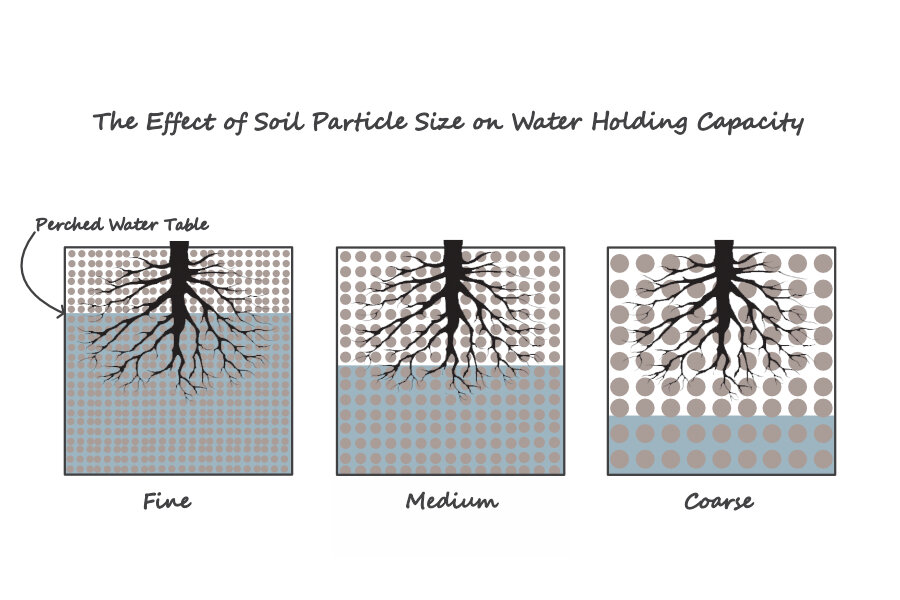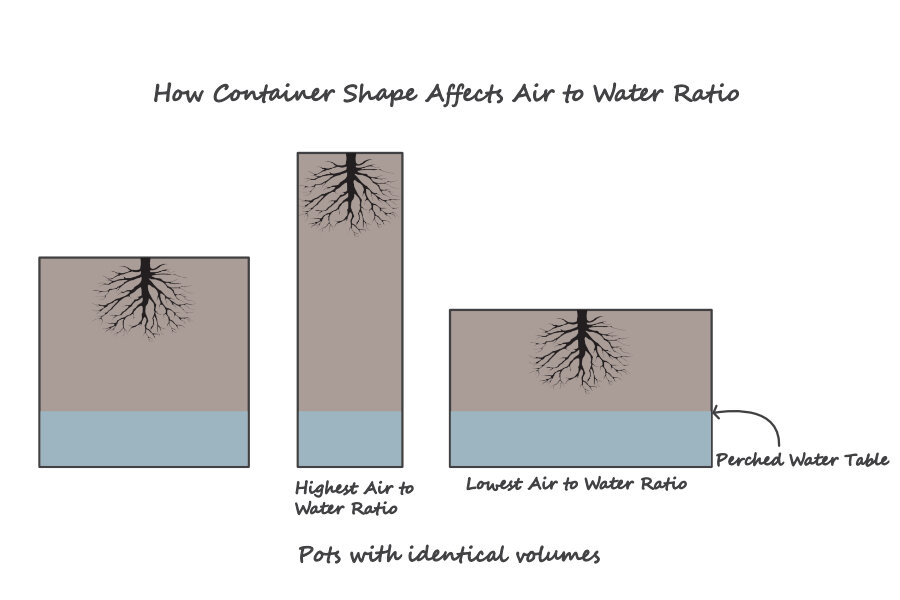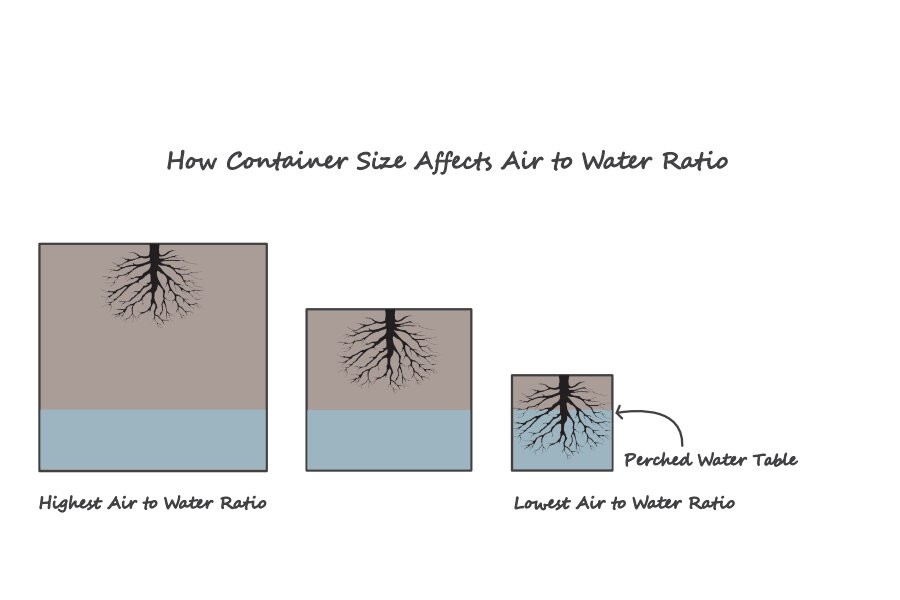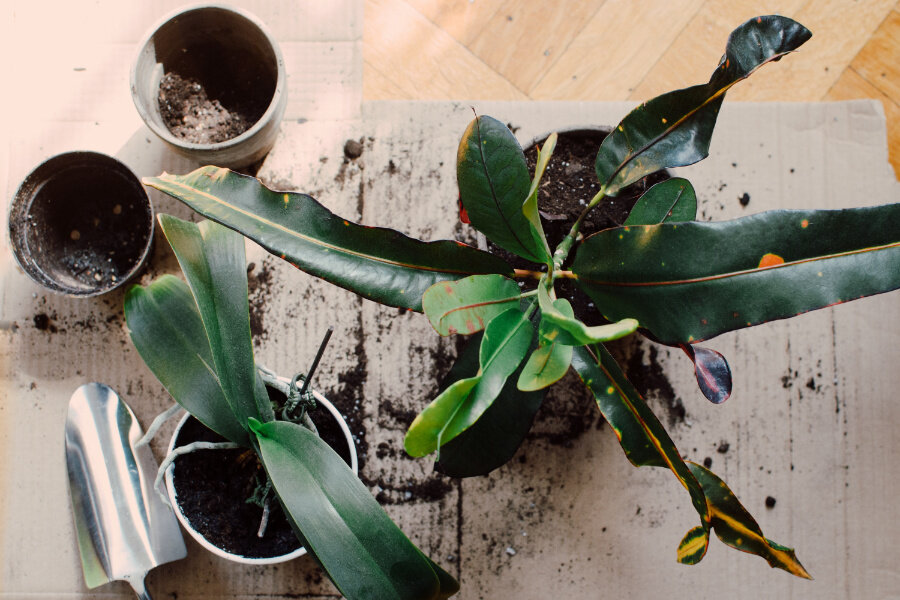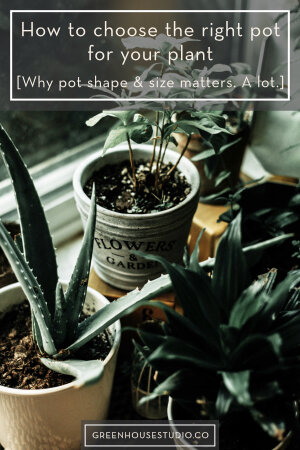How to choose the right pot for your plant [Why pot shape & size matters. A lot.]
Choosing a pot for your plant may seem like it’s only a matter of aesthetics, but the size and shape of your planter along with the soil/potting mix you choose has a direct result on the amount of available water for your plant.
If you’re serious about growing your potted plants as successfully as possible, whether indoors or out, it’s really helpful to have a grasp of the science behind how water and soil interact under different conditions in containers.
In addition to choosing the most attractive planter to show off your prize plant, (also important!) this’ll help you make informed choices about what kind of pot to use for your plants’ long term health and growth.
Container soil science 101
How potting mix works with water in your pot
Why your plant’s pot shape & size matters
Choosing pots for plants
Container Soils 101
Let’s start with basic container soil science. Yep, that’s really a thing. I took an entire course devoted to container soils while at UC Davis. Also, containers are the term used by the horticulture/nursery trade which we would usually call a pot or a planter.
Basically, when you buy a pre-made potting mix, you’re looking for planting mix that comes ready-made to create the right balance of air-filled and water-filled pore space for your plant and your growing environment when you water it.
The potting mix must be able to hold sufficient water and nutrients while loose enough to allow for root and water movement and gas exchange (oxygen primarily) in the root zone.
This is why a succulent mix has larger quantities and sizes of soil aggregates in it like pumice, perlite and sand to promote increased drainage over say the ideal mix for a low-land carnivorous bog plant.
Note: I sometimes use the term soil but it’s really a misnomer. Potting mixes contain no actual “soil” or “dirt” taken from the ground or field. They are made from a combination of organic and inorganic materials and are often referred to in the nursery trade as soilless mixes or soilless media for that reason. We aren’t going to split hairs here though.
Photo: Neslihan Gunaydin via Unsplash
[Want more design inspo and helpful plant tips? Let's hang out on Instagram!]
Container Soils 101: How potting mix works with water in your pot
Every container media (potting mix) has what’s called a Matric Potential.
Matric Potential is the ability of a potting mix to hold water.
Basically, if the space between soil particles is sufficiently small, then the combination of surface tension (which is caused by cohesion in water) and adhesion between the water and soil particles will propel water up and into those spaces between soil particles.
The smaller the soil particle sizes, the greater the Matric Potential.
I.e. - Heavy clay soil holds more water than sand.
The water saturation level (aka “perched water table”) of a pot is determined by the particle sizes of a potting mix or soil. Graphic: Greenhouse Studio
When you add water to a potting mix though, even though it’s Matric Potential is the same throughout the pot (because it’s all the same soil mix), it is not distributed evenly throughout the pot. This is because of two opposing forces at work: gravity and capillary action.
Gravity - exerts a downward pull on the water, causing it to move to the bottom of your pot and either sit there until it evaporates (if no drainage) or drain through the drain holes.
Gravitational force is higher at the top of your pot than at the bottom.
Capillary Action - exerts an upward pull on the water. Capillary action is the ability of a liquid to flow into narrow spaces (between soil particles) even in the presence of gravity.
Think if you held a paper towel upright with just the bottom edge touching water. You’d see the water start to move up the paper - this is capillary action.
Gravity is a constant throughout a container, but gravitational potential is greater at the top of your container and lower at the bottom. Because of the gradual decrease in gravitational potential towards the bottom of the container, the soil particles are able to hold more water at the bottom than the top. This causes formation of what’s called a perched water table at the bottom of the pot. A perched water table is a layer of water saturation.
Gravity & Capillary Action: capillary action will pull water up from a certain point, and below that point, gravity keeps the water from moving up. It’s basically chemistry vs. physics. Graphic: Greenhouse Studio
So a pot’s perched water table for a given container media is determined by the saturation point where the capillary action in the soil is canceled out by the force of gravity.
Why your plant’s pot shape & size matters
All pots have a perched water table. A more absorbent mix (heavier soil) will have a higher perched water table, and a less absorbent mix (lighter soil) will have a lower saturation level.
For a given potting mix, the perched water table/level of water saturation is the SAME regardless of the size and height of your pot.
A container that is shallow and wide will hold water in closer contact to the plant’s roots than one that holds the same volume but is taller. Why? Gravity pulls water down through the container and out of the drainage holes.
Container height affects the relative amount of water versus air. With identical potting mix, the perched water table occurs at the same height, regardless of a planter’s size. So ALL pots with the same potting mix will have identical perched water tables.
Planter shape
Given the same volumes and potting media, short pots will have the same perched water table as tall pots, so a greater percentage of container volume is filled with water in a shorter, wider pot.
This means a tall 5-gallon container holds less water than a short and wide 5-gallon container.
These planters are identical in volume, and given the same potting mix, all have the same level of saturation (perched water table). The shortest pot on the right has the highest air:water ratio. Graphic: Greenhouse Studio
Planter size
It’s the same concept with pot size:
With identical soil, the height of the perched water table in a small planter will be the same as a larger pot, therefore the ratio of water to air is highest in the largest pot.
These planters are all different sizes, and given the same potting mix, all have the same level of saturation (perched water table). This means the largest pot on the left has the highest air:water ratio. Graphic: Greenhouse Studio
Yep, you heard it here first: size matters!
With identical soil, the height of the perched water table in a small planter will be the same as a larger pot, therefore the ratio of water to air is higher in the smaller pot.
Therefore, the size of the pot you choose for your plant for a given soil mix will determine how much air and water your roots get.
Moth orchid (Phaelenopsis) left, and Croton (Codiaeum) on right. Photo: Kelly Sikkema via Unsplash
How to use this info when choosing pots for plants
So how do we apply all this horticultural science to actually selecting a new home for our plants? Well, here are a few examples:
Container Choice
Knowing that for containers with identical volume, tall, narrow pots dry out faster than short, wide pots, I’d steer clear of choosing a tall, narrow pot for my maidenhair fern, since they like to be kept uniformly moist at all times.
That same tall, skinny pot could be perfect for a specimen cacti where the extra gravitational force will make for excellent drainage.
Conversely, a short and wide bonsai dish style pot could be ideal for carnivorous plants that naturally live in bog-like conditions and like to be kept wet.
That same short and wide bonsai container wouldn’t be a good choice for most orchids since most are epiphytes (so they live on trees, not in soil) and need infrequent watering with excellent drainage, so again, the short, wide container would hold more water than a taller, narrow one, which wouldn’t be ideal for an orchid.
Caveat though - container size and shape are important factors, but they can sometimes be mitigated for with proper management.
For example, the orchid can do just fine in a short container provided it has the proper orchid bark mix, excellent drainage, and is watered infrequently. Keep in mind though, if the pot is quite wide, it will hold more water than a small pot that’s just short and small.
I wouldn’t try to keep that Maidenhair fern in a tall, skinny container though - you wouldn’t be able to water it often enough to keep it’s lacy light green fronds from turning into the dreaded crispy brown Maidenhair fronds.
Watering Schedule
Scenario: You are the proud plant-parent of two hoyas, (semi-succulent leaves and shoots). One hoya you planted in a large, wide pot to give it plenty of room to grow, but now it’s seeming a bit waterlogged. The other hoya which was planted in a smaller yet taller container is fine. Why?
That short, wide and large pot will have a higher level of saturation (perched water table) and will also hold more water (due to volume) than a taller pot of less volume. So this is a clue that you need to cut back on the watering for the hoya in the wide pot since semi-succulent hoyas don’t like to be kept too wet.
Soil/Potting Mix Choice
Going back to our two hoyas above; if you were at the repotting stage and planning on using different shaped pots of the same volume for the same size plants; i.e., one’s going into a taller container than the other, use a lighter soil mix in the shorter, wider container. (By adding extra perlite to the bagged mix for example.)
Again, this goes back to the perched water table being the same regardless of container size and shape for a given soil.
Keep in mind though, a smaller pot (less volume) will dry out faster than a larger pot generally, but when it’s wet, it’s saturation level will be identical to the larger pot containing the same soil mix.
In looking at this as a whole, we have to consider BOTH container size and shape.
Thanks for bearing with me through this - you’re a trooper! It’s not the most fun post to read, but like I said in the intro, if you’re serious about doing right by your plants and growing them to their full potential, how water and soil work together in a planter is important to understand.
Want to actually see a great selection of pots now? Check out this Pot Roundup post!
To your growing success!
Don’t forget to sign up below for your free design guide on how to bring the outdoors in to create a nature-inspired home you love!
Sources
Graphics and information adapted from Management of Container Media by Richard Evans, Ph.D., UC Davis, for the course ENH 120.
Enjoy the post on Choosing The Right Pot For Your Plant? Pin it for later!



